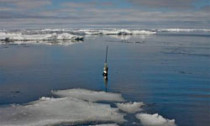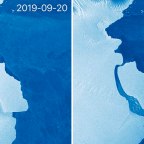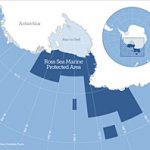
It is easy to be gloomy about the future of the planet – except, perhaps, for 1.55 million sq/km of water in the Southern Ocean. The Antarctic’s Ross Sea made fleeting headlines 10 days before the US presidential election when it became the world’s first marine “park” in international waters. Amid fears that president-elect Donald Tump intends to sabotage the Paris climate agreement, the 35-year pact to protect the Ross Sea is beyond his reach, according to one of its chief negotiators, Mike Walker of the Antarctic Ocean Alliance.
The deep bay, which teems with krill and toothfish and sustains whales and penguins, has several close links with Ireland. When explorer Ernest Shackleton set out on his Imperial Trans-Antarctic expedition in 1914, the Ross Sea was his final destination after crossing the continent and reaching the South Pole.
Shackleton sent an advance party from Australia, charged with setting up a series of supply depots for the last quarter of the planned traverse, from the Ross Sea to the Beardmore glacier. Three members of the party died, and the experience was horrendous for those who survived. Sadly, their mission was in vain, as Shackleton’s ship, Endurance was crushed in the Weddell Sea on the opposite Antarctic coast.The location, named after British naval officer James Clark Ross, is particularly significant. It is regarded as the last “intact” marine ecosystem on the planet. The Southern Ocean itself is believed to produce about 75 per cent of nutrients sustaining life across the world’s oceans.
International protection
As Mike Walker explains, the marine park’s inception is borne out of a system devised to protect the Antarctic continent in 1959, at the height of the Cold War. “At that time, the Antarctic landmass was set aside for international protection in the interests of peace, science and humanity.
The EU and 24 other countries, including the US, China and Russia, are members of the Commission for the Conservation of Antarctic Marine Living Resources, which set targets from 2009 for protection of habitats within southern seas.
It took five years of negotiations and two weeks of intensive talks in October to close a deal. Fishing is not banned outright in the Ross Sea, but restricts it in sensitive habitats close to the Antarctic continent.
Russia and China will be most affected by the agreement, which had been proposed as a permanent deal before the almost inevitable compromise. Their fleets catch large quantities of toothfish, which is a protein source for Orca whales. Several “research” zones will permit catches of krill and toothfish for this purpose only.
“The scientific advice was that protection should be long-term and permanent, as the view is that marine protection areas should be long-lived and large,” Walker says. “However, it is clearly very difficult to forge a consensus relating to the high seas, so this is an important milestone.”
Two additional proposals in east Antarctic waters and the Weddell Sea are now under discussion, he says, and the Antarctic Ocean Alliance has proposed areas covering some 40 per cent of the Southern Ocean for lasting protection.
UN convention
The Ross Sea park will give a fillip to the United Nations Convention on Biological Diversity. This sets targets to increase the amount of well-managed protected areas of ocean to 10 per cent globally by 2020, according to Anthony Grehan, a senior research fellow in earth and ocean sciences at NUI Galway.
“Until recently, reaching this target was not looking promising, with only 4 per cent of areas protected,” Grehan says. “The Ross Sea designation, along with the creation of a number of other marine parks in remote areas – by the US, New Zealand, Chile, France and Britain, among others – is helping to address the deficit.”
Grehan has been active in conservation initiatives to protect deep-water coral in Irish waters, and has just begun working on an EU Horizon 2020 project. This addresses large-scale conservation issues at a time of growing interest in “blue growth” for economic gain in the north Atlantic.
“Large marine protected areas are useful, as they encompass more habitat, and in turn more species,” Grehan says. Effective restrictions relate not just to to fishing, but to extractive activities such as deep-sea mining at hydrothermal vent sites along mid-ocean ridges, he says. Satellite tracking of vessel activity at sea makes surveillance and protection of such areas far more feasible.
The EU Marine Strategy Framework Directive calls for member states to ensure healthy oceans and seas by 2021, and Ireland must produce a marine plan by this date. It has recently enacted the marine spatial planning directive into Irish law.
A recent article in the journal Marine Policy has raised questions about the whole approach. It argues that designating large marine protected areas could threaten to undermine the “very purpose and objective” of UN biodiversity targets by distracting attention from protection of smaller, more intensely used areas. Grehan disagrees, pointing out that the involvement of fewer stakeholders in the larger and more remote marine parks in international waters makes for easier and, therefore, inspiring, “wins”. “The situation becomes much more complex closer to land, where there are numerous competing claims to use marine space,” he says. “The recent emphasis on marine spatial planning is intended to provide a means to reconcile these competing needs while ensuring environmental sustainability.”
Economic livelihoods
Such “competing needs” are multiplying, ranging from hydrocarbon and mineral extraction to fish farming to offshore renewable energy projects. Inshore fishing fleets, meanwhile, are finding it increasingly difficult to sustain an economic livelihood.
“I think no one questions the idea that the larger the marine area protected, the more effective it is,”says Peter Tyndall, scientist and spokesman for Galway Bay Inshore Fishermen’s Association. “However, there is also an assumption that inshore coastal areas should be managed for, rather than by, communities, and that is not the case.”
The association, for example, has reached its own consensus on shrimp stocks. Members have agreed to put back the shrimp season from August to October, when shrimp grow more rapidly and fetch more on the quay.
“The fishermen also reduced their gear and used graders to release small shrimp,” Tyndall says. “It shows that if they are trusted with management of a resource on which they depend, it can produce positive results.
“That kind of management is better than a blanket closure, but it also requires support from the State to ensure larger players can’t come into these grounds.”













Social Profiles